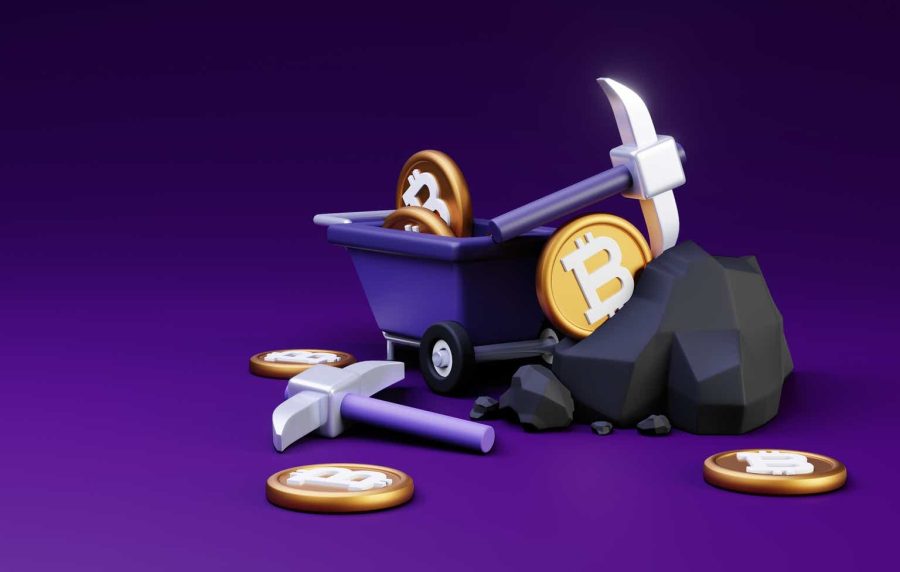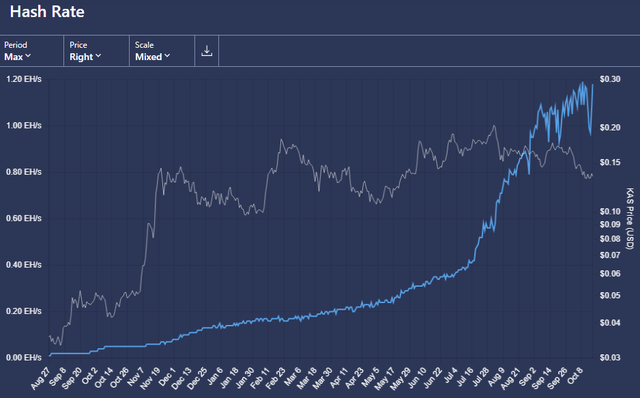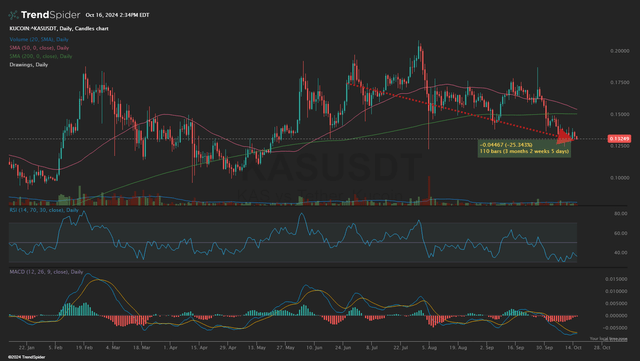Summary:
- Marathon Digital’s pivot to Kaspa mining has likely not yielded lasting profitability, as mining difficulty has increased simultaneous to a 25% drop in KAS price.
- Bitcoin mining remains challenging with profitability near historic lows, despite MARA’s Slipstream product slightly boosting transaction fee revenue.
- MARA’s strategy of borrowing to buy Bitcoin has significantly increased its BTC holdings, but at higher interest rates compared to competitors like MicroStrategy.
- With 25.7% short interest, MARA shares are highly shorted, reflecting market skepticism, yet potential for short squeezes could drive price spikes.
lerbank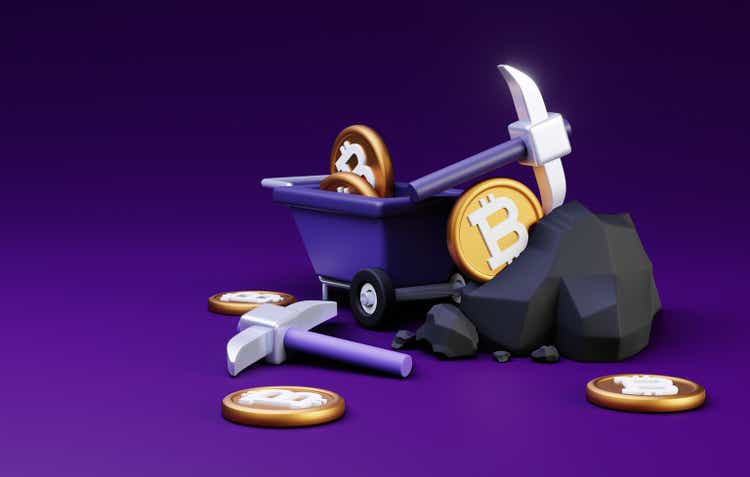
Back in May when I last wrote about Marathon Digital Holdings (NASDAQ:MARA) for Seeking Alpha, I called the stock a ‘hold’ and made note of the company’s edge over other mining pools in average block fees. I also highlighted the trend in production and industry profitability, among other things. Since then, we have some new catalysts that I think lend credence to the notion that MARA shares will ultimately serve as little more than trading instruments rather than a quality investment over time.
In this update, we’ll look at MARA’s ‘diversification’ of the company’s mining footprint to another cryptocurrency, re-assess how MARA Pool is progressing against the competition, and consider the company’s new BTC acquisition strategy.
Pivoting To Kaspa Mining
In late-June, MARA announced it had begun mining Kaspa (KAS-USD) in addition to its Bitcoin (BTC-USD) mining operation to diversify away from just BTC. In the press release, MARA mentioned the Kaspa mining strategy actually started in September 2023. Marathon also noted Kaspa mining margins of up to 95% in certain cases, given the price of KAS and the low network difficulty rate for miners. Marathon guided for full energization of its 60 petahash Kaspa ASIC purchases by the end of Q3. The chart below is quite telling:
Kaspa currently has a global hash rate approaching 1.2 EH/s. But what I find interesting is the timing of the enormous spike in KAS mining in mid-July. The global hash rate for Kaspa mining was 0.35 EH/s the day Marathon announced its Kaspa mining strategy. Global exahash is now roughly three times that level, and yet, the price of KAS is actually down 25%:
So any real Kaspa profit edge that MARA had in June before announcing its Kaspa strategy is likely gone at this point. It’s three times more difficult to generate a coin that is worth 25% less than it was the day of MARA’s press release. If the company’s goal was to tout a profitable new business line, it doesn’t appear that it has lasted very long.
Bitcoin Mining Challenges
I think it’s important to understand that the very notion that MARA would mention Kaspa mining is not a small admission from the biggest public miner in the industry that mining BTC is a bad business:
Bitcoin Hashprice, 1yr (Hashrateindex)
Though it’s slightly ahead of the lows from August and September, the US dollar-denominated hash price for Bitcoin has been under $50 per PH/s for most of the last 5 months. Bitcoin mining profitability is still very much near the lowest levels in the history of the chain. I’ve covered this ad nauseam at this point, but the fixed supply of the native asset means miners need higher BTC prices in perpetuity or a larger share of transaction fees as a percentage of total rewards.
Miner Rewards Distribution (IntoTheBlock)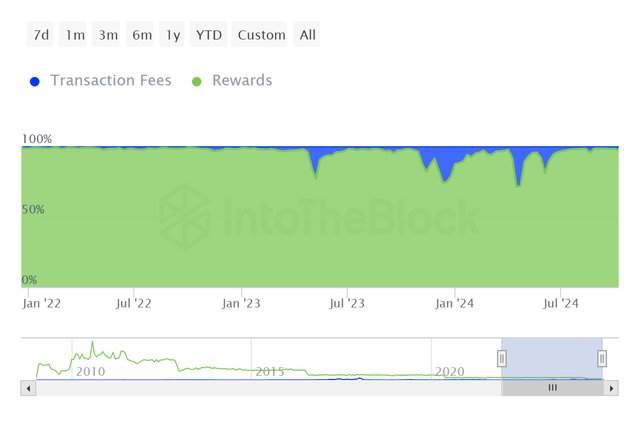
I think it should go without saying, Bitcoiners would want to see the latter option be the way miners are incentivized going forward. So far, we’re simply not seeing the stickiness of transaction fees for longer than a few weeks at a time. Since the April halving, transaction fee percent of total miner rewards has averaged about 4%. This is inline with what the average has been since the beginning of 2022. However, more recently, that average has dipped back below 2%.
To company’s credit, MARA has taken steps to get more than its ‘fair share’ of revenue from transactions through its Slipstream product. I covered this in my last MARA article from May, and I would recommend reading that for more details. But the main takeaway is MARA Pool can generate more from transaction fees if users decide to go to MARA directly for transaction validation. In May, MARA Pool was getting an 11% bump over expected block fees, which, I believe, was a direct result of Slipstream.
| Rank | Pool | Blocks | Avg Block Fees |
Empty Blocks |
|---|---|---|---|---|
| 1 | Foundry USA | 7748 (29.33%) | -1.71% | 0 (0.00%) |
| 2 | AntPool | 6682 (25.3%) | -1.73% | 34 (0.51%) |
| 3 | ViaBTC | 3533 (13.37%) | -1.61% | 4 (0.11%) |
| 4 | F2Pool | 2784 (10.54%) | -2.18% | 6 (0.22%) |
| 5 | MARA Pool | 1086 (4.11%) | +0.65% | 0 (0.00%) |
| 6 | Binance Pool | 792 (3%) | -1.73% | 6 (0.76%) |
| 7 | SpiderPool | 777 (2.94%) | -6.45% | 27 (3.47%) |
| 8 | Luxor | 603 (2.28%) | -1.94% | 5 (0.83%) |
| 9 | Braiins Pool | 469 (1.78%) | -1.20% | 0 (0.00%) |
| 10 | SBI Crypto | 466 (1.76%) | -2.44% | 0 (0.00%) |
Source: Mempool, last 6 months as of 10/16/24
We’ve since seen a normalization of that block fee premium going to MARA Pool. As of article submission, the block fee bump for MARA Pool is just 0.65% over the last 6 months. The good news is, MARA Pool is still outperforming the other mining pools even at that rate.
Adopting The ‘Infinite Money Glitch’
Bitcoin mining is a very difficult business long term; that’s fairly obvious at this point. I suspect MARA already knows the same is true for Kaspa mining today – which has 87% of its total supply already mined. What can the company do to benefit from long term price appreciation of BTC if there is only so much mining revenue remaining? It can adopt the ‘infinite money glitch’ approach that has been pioneered by MicroStrategy (MSTR):
Monthly BTC Treasury (MARA Holdings, Author’s Chart)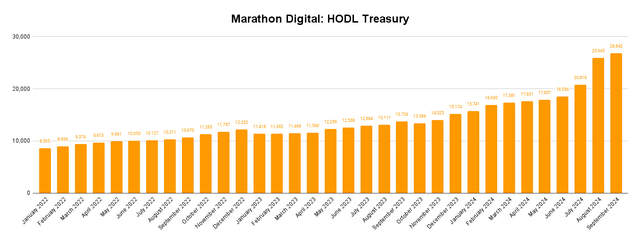
Since the end of June, we’ve seen MARA’s BTC position explode from 18,536 to 26,842 BTC. The company has mined 2,070 BTC since the end of June but grown its treasury by over 8.3k BTC over that period of time. This 45% three-month rip in MARA’s HODL stash is mostly attributable to MARA borrowing to buy Bitcoin. The company bought $100 million in BTC in July and $249 million worth of BTC in August.
For the August purchase, Marathon Digital issued $300 million in convertible senior notes due in 2031. These notes pay 2.125% interest, which is a much higher rate than what MicroStrategy has been paying creditors to do exactly the same thing. The good news is at $67k, Marathon already has a $31 million paper gain on those August BTC purchases as they came at an average price of $59.5k.
Short Interest Headed Higher
For me, the long term investment thesis for MARA shares is getting a bit more challenging. The company’s mining operation needs higher BTC prices to be profitable. I believe the Kaspa mining experiment is already a non-winner. And the short interest in the company probably tells the tale:
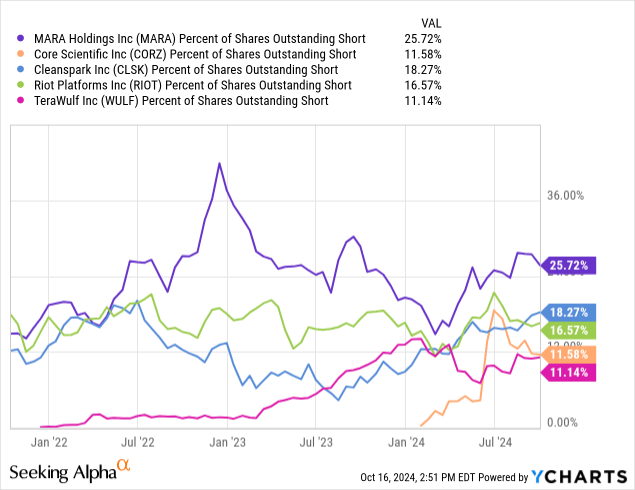
At 25.7%, MARA has the largest percentage of shares outstanding sold short of any of the top 5 BTC mining companies in the public markets. Being a highly shorted stock isn’t anything new to MARA, but the current 25.7% level would be near the high of the year. There are two ways to look at this, though. On one hand, shorting a stock shows a high level of conviction in future price declines and with more than a quarter of the shares sold short, the market is telling investors this is not a stock to buy.
On the other hand, if the bears are wrong and are forced to cover, we could theoretically see an explosion to the upside as bears get squeezed:
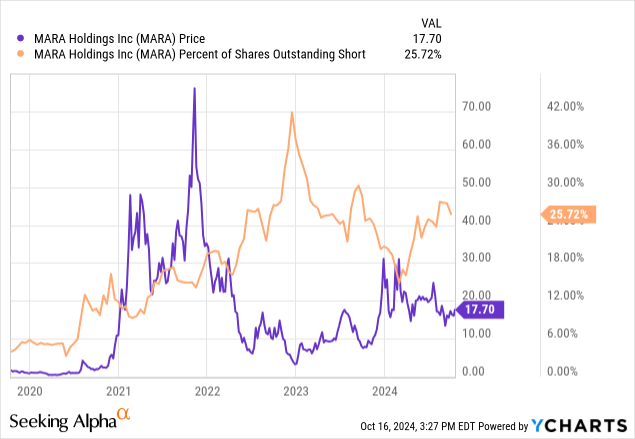
We saw this happen twice in 2023 when short interest declines directly coincided with large price moves higher for MARA shares. Essentially, bears may not be wrong about the fundamental problems with Marathon’s long-term business model, but that doesn’t necessarily mean the price of MARA shares can’t move higher anyway.
Investor Takeaways
I’m still rating MARA shares a ‘hold’ today because I suspect Bitcoin is very close to a technical breakout of 6 month resistance. Due to the fact that MARA has such a large BTC position, I suspect BTC price appreciation will drag MARA shares higher as well. But there can be little doubt at this point that the market has been rewarding BTC miners that have pivoted to HPC services. MARA seems to be pivoting more to the MicroStrategy model of borrowing long term to buy Bitcoin. If you like that approach, MSTR is probably a much better expression of that idea because the company has lower borrow costs and doesn’t have the depreciation baggage that public miners have.
Editor’s Note: This article covers one or more microcap stocks. Please be aware of the risks associated with these stocks.
Analyst’s Disclosure: I/we have a beneficial long position in the shares of KAS-USD, BTC-USD either through stock ownership, options, or other derivatives. I wrote this article myself, and it expresses my own opinions. I am not receiving compensation for it (other than from Seeking Alpha). I have no business relationship with any company whose stock is mentioned in this article.
I'm not an investment advisor.
Seeking Alpha’s Disclosure: Past performance is no guarantee of future results. No recommendation or advice is being given as to whether any investment is suitable for a particular investor. Any views or opinions expressed above may not reflect those of Seeking Alpha as a whole. Seeking Alpha is not a licensed securities dealer, broker or US investment adviser or investment bank. Our analysts are third party authors that include both professional investors and individual investors who may not be licensed or certified by any institute or regulatory body.
